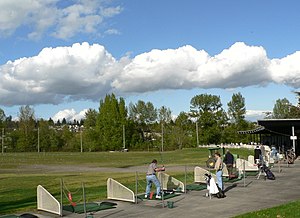
Golf is played on a tract of land designated as the course. The course consists of a series of holes. A hole means both the hole in the ground into which the ball is played (also called the cup), as well as the total distance from the tee (a pre-determined area from where a ball is first hit) to the green (the area surrounding the actual hole in the ground). Most golf courses consist of nine or eighteen holes. (The "nineteenth hole" is the colloquial term for the bar/grill at a club house).
The first stroke on each hole is done from the Tee (officially, teeing ground), where the player can use a tee (a small wooden or plastic peg) to put his ball on, which makes the tee shot easier. After teeing off, a player hits the ball again from the position at which it came to rest, either from the fairway (where the grass is cut so low that most balls can be easily played) or from the rough (grass cut much longer than fairway grass, or which may be uncut) towards the putting green. From there, it is putt to the hole until the ball comes to rest in the cup. Many holes include hazards, which may be of two types: water hazards (lakes, rivers, etc.) and bunkers. Special rules apply to playing balls that come to rest in a hazard, which make it undesirable to play a ball into one. For example, in a hazard, a player must not touch the ground with his club before playing a ball, not even for a practice swing. A ball in any type of hazard may be played as it lies without penalty. If it cannot be played from the hazard for any reason, it may be removed by hand and dropped outside the hazard within two club lengths and a penalty of one stroke. If a ball was observed entering a hazard but cannot be found, it may be replaced by dropping another ball outside the hazard, with one stroke penalty. Exactly where a ball may be dropped outside a hazard is governed by strict rules. Bunkers (or sand traps) are hazards from which the ball is more difficult to play than from grass. As in a water hazard, a ball in a sand trap must be played without previously touching the sand with the club.
The grass of the putting green (or more commonly the green) is cut very short so that a ball can roll easily over distances of several yards. To putt means to play a stroke, usually but not always on the green, wherein the ball does not leave the ground. The direction of growth of individual blades of grass often affects the roll of a golf ball and is called the grain. The slope of the green, called the break, can also affect the roll of the ball. The cup is always found within the green, and must have a diameter of 108 mm (4.25 in.) and a depth of at least 100 mm (3.94 in.). Its position on the green is not static and may be changed from day to day. The cup usually has a flag on a pole positioned in it so that it may be seen from some distance, but not necessarily from the tee. This flag and pole combination is often called the pin.
Putting greens are not of all the same quality. Generally, the finest quality greens are well kept so that a ball will roll smoothly over the closely mowed grass. Golfers describe a green as being "fast" if a light stroke of the ball allows it to roll a long distance. Conversely, a green is termed "slow" if a stronger stroke is required to roll the ball the required distance.
The borders of a course are marked as such, and beyond them is out of bounds, that is, ground from which a ball must not be played. Some areas on the course may be designated as ground under repair, meaning that a ball coming to rest in them may be lifted and then played from outside such ground without penalty. Certain man-made objects on the course are defined as obstructions, and specific rules determine how a golfer may proceed when the play is impeded by these.
At most golf courses there are additional facilities that are not part of the course itself. Often there is a practice range or driving range, usually with practice greens, bunkers, and driving areas (where long shots can be practiced). There may even be a practice course (which is often easier to play or shorter than other golf courses). A golf school is often associated with a course or club.


No comments:
Post a Comment